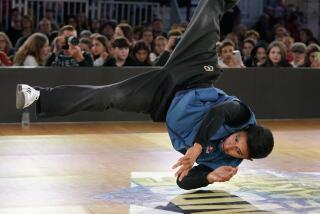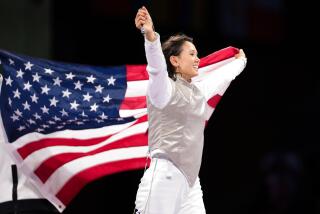A Master of the Game Turns Swordplay Into Child’s Play
- Share via
Buzz Hurst was about to give a 50-minute fencing lesson to four boys, average age 10. They were outfitted with padded jerseys and wire masks and issued swords--long, thin foils like the weapon Zorro used to carve his trademark letter on a villain’s chest. Lesson No. 1: Even though the tips are covered, Hurst tells his young students, “When you’re not doing drills, walk around with the point down.”
It might have been bewildering to see yellow handbills with this message on Valley telephone poles recently: “Learn to Use a Sword--Basic Beginning Lessons.” Fencing isn’t what it was in the 17th Century, when little D’Artagnans took lessons from the Captain of the Queen’s Guard, then set out to swash, buckle and maim their way through Europe. AK-47s are the weapon of choice in street combat today. And swords are never worn in public, partly because of space problems in elevators and public restrooms.
Vicki Israel, director of the Lanark Park Recreation Center in Canoga Park, distributed hundreds of the flyers to drum up interest in the fencing classes. Israel, looking for youngsters to “start on the road to the U. S. Olympic Fencing Team,” was able to get a grant from the Amateur Athletic Foundation, which supports local amateur sports with surplus funds from the 1984 Olympics. The money enabled the rec center to purchase 25 outfits--mask, jersey, glove, foil--and pay for the services of Edwin K. (Buzz) Hurst II.
Hurst is a modern-day Captain of the Queen’s Guard, teaching little D’Artagnans how to parry, thrust and riposte. Hurst, 47, a Navy reconnaissance pilot who flew 75 missions over Vietnam, is heavily involved with U. S. Olympic fencing and is one of this country’s estimated 50 fencing masters, “the fencing equivalent of a Ph. D.,” he says. “I had to write a thesis and take an oral exam.”
Hurst, who lives in Woodland Hills, has made his living as a fencing coach for the past 12 years, including a stint of five years at Stanford. These days he free-lances, giving private lessons and also teaching the free twice-weekly class--which runs through March at Lanark Park. He trains Sylvia Ganchev of Marina del Rey, the 1988 national women’s saber champion, and also coaches the Salle Grenadier, a Beverly Hills club team. But teaching inexperienced youths requires him to alter his methods: light on teaching, heavy on fun. Youngsters get antsy during the lessons, then break into a smile when Hurst gives them the go-ahead to sword fight.
“I’m sure the reason my son wanted to come here had something to do with watching swashbuckling in the movies,” says Peggy Tropp of Woodland Hills, who was watching Joshua, 9. Joshua was adjusting his mask. Wearing one is like looking through a screen door. “The mask is OK as soon as you get used to it,” he says.
Occasionally, the boys’ concentration wavered, and Hurst, a short man with dark hair and military bearing, had to correct them: “Have you guys mastered this technique or do you want to take a lesson?” Later during a break, the boys found a basketball and started shooting two-handers, which prompted Hurst to bark: “Can the basketball!”
In the first few minutes of class, the boys learned the basics, some of which are not unlike golfing techniques--”Lay your thumb on top,” Hurst tells them--along with terminology and fencing etiquette. “Salute before you put your mask on,” Hurst says. “Now, heels together, salute, en garde .” Like the martial arts, fencing requires learning a series of small moves and incorporating them into a fluid whirlwind of action. But the boys looked as if they were trying to swat flies. Hurst stopped them in mid-hack.
“Fencing is not bam-bam-slash-bam like Errol Flynn,” he says. “And you don’t use the side of the blade. It doesn’t count. Only the point does. You’re not trying to wound some guy. You hit them here, in the jacket.” Hurst was pointing to his heart--it may sound ghoulish, but a fencer scores only when he strikes an opponent in a place that, left unprotected, would have killed him.
“Fencing is a combat sport, like boxing and wrestling, but you don’t get your brains beat out,” says Hurst, who also teaches an intermediate and open class in the Lanark gym (students pay $6 an hour). Despite the presence of a potentially lethal weapon, the sport is safe, Hurst says. “Three or four years ago, when the USOC was looking for insurance, underwriters said that fencing had one of the lowest insurance rates.”
But youngsters don’t take up a sport based on actuarial tables. Fencing is not popular in this country. “You don’t hear a lot about it,” Israel says. There is only one fencing facility in Los Angeles, the Westside Fencing Center in Culver City, and about 15 club teams in the L. A. area, Hurst estimates. Fencing is not a CIF-sanctioned sport, although some high schools offer it as a club sport. Among California colleges, seven field varsity fencing teams.
Cal State Northridge, where Hurst received his master’s degree in physical education and coached fencing from 1976-79, dropped the sport in 1984. “They replaced it with aerobic dance,” Hurst says with a look of disgust. “You got to be trendy these days.”
Fencing has never been trendy, except among the Eastern gentry and at the service academies. “It never really got beyond the Mississippi,” Hurst says. The United States has never won an Olympic gold medal in fencing, which has been dominated by the Europeans, but U. S. women had what was considered a good showing this year, finishing sixth in the team scoring.
There probably won’t be a time when U. S. fencing is ever big enough to encourage steroid use, but it’s still “an exciting alternative to sports like football and basketball,” Israel says. Size doesn’t matter. Fencing is a sport that requires discipline, catlike reflexes, poise and balance. It provides an aerobic workout and is especially tough on the legs. Age is not a big factor in proficiency: The world champion several years ago was 55.
“Fencing is similar to tennis,” Hurst says. “You can make up with experience and cunning what you begin to lose in your legs.”
Hurst, an All-American fencer at the Naval Academy in 1962, still has a top rating in the saber and competes in regional meets. But coaching is what he enjoys most, even though the financial rewards are not great. “Fencing masters,” he says, “generally don’t get into this for the money.”
More to Read
Go beyond the scoreboard
Get the latest on L.A.'s teams in the daily Sports Report newsletter.
You may occasionally receive promotional content from the Los Angeles Times.






